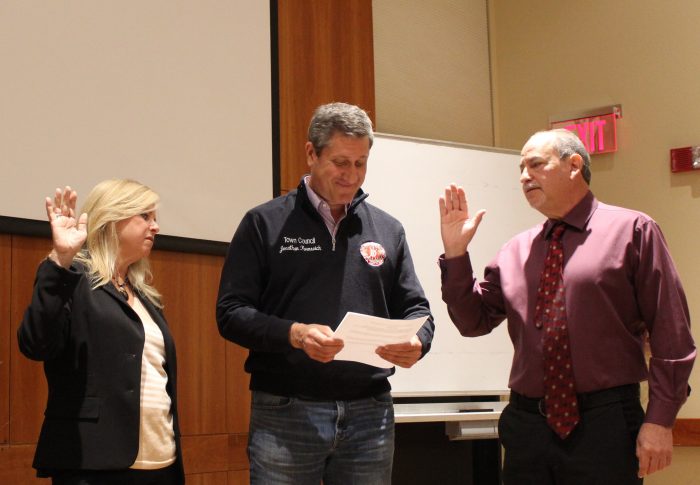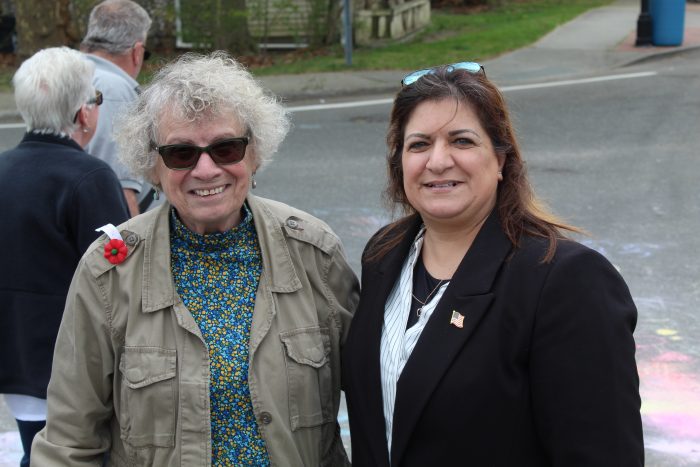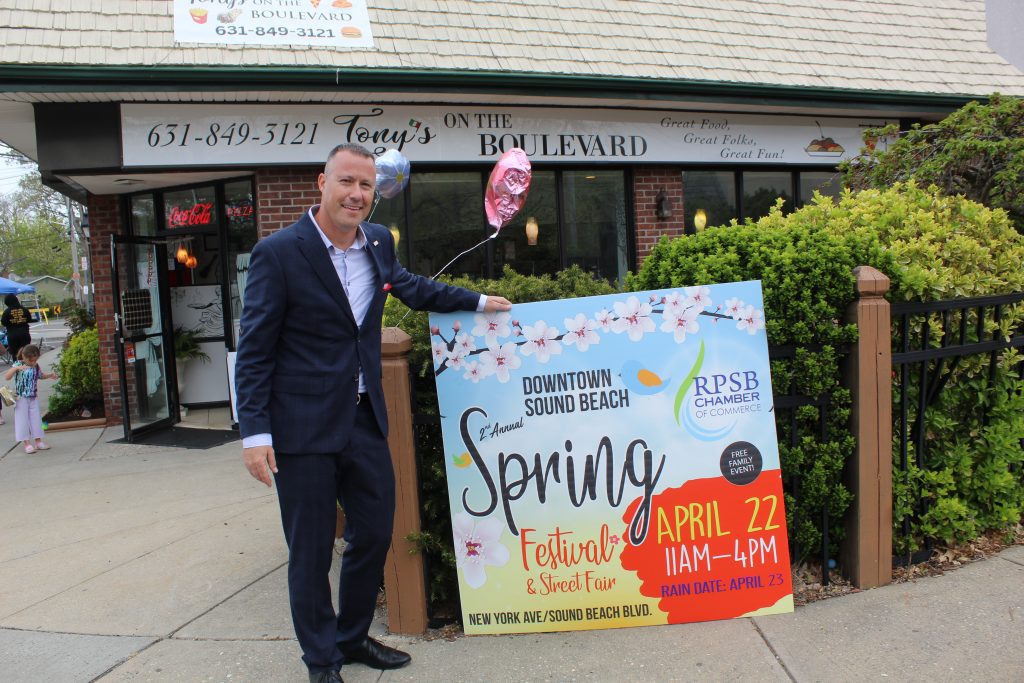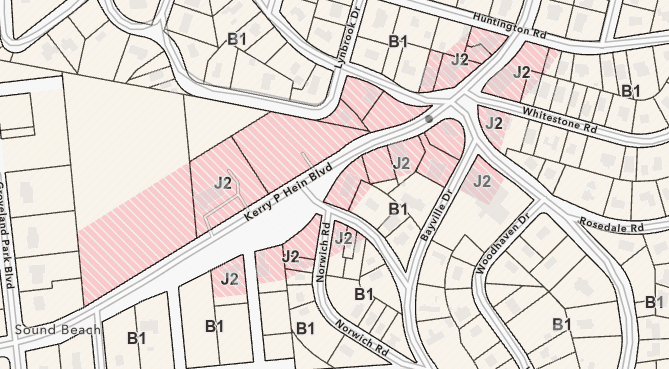The newly reconfigured executive board of the Port Jefferson Station/Terryville Civic Association went straight to work Tuesday night during the body’s general meeting April 25.
Nearly six dozen people turned out as former civic president Ed Garboski and vice president Sal Pitti left their posts, transitioning leadership authority to Ira Costell and Carolyn Sagliocca, respectively.
Village of Port Jefferson Mayor Margot Garant, former New York State Assemblyman Steve Englebright (D-Setauket) and representatives of state Sen. Anthony Palumbo (R-New Suffolk) and Suffolk County Legislator Kara Hahn (D-Setauket) were all in attendance.
Town of Brookhaven Councilmember Jonathan Kornreich (D-Stony Brook) officiated over a formal swearing-in ceremony for the newly elected civic officers. He thanked the departing civic leaders and congratulated their successors.
“There’s an energy in this community that we haven’t felt in years,” he said. “It’s a whole new optimism, and in large part, that’s because of the drive out of this civic organization.”
To Garboski and Pitti, the councilmember added, “You two are fantastic civic leaders, and I have every confidence that the new board will continue to focus and do the work that you’ve done.”

Land use
Costell quickly got moving, announcing the creation of a land use committee headed by Sagliocca, which will monitor development and related land use activities within the hamlet.
Further expanding on this theme, Costell articulated his vision for overseeing the redevelopment of the area, narrowing his focus around the projected $100 million proposed investment into Jefferson Plaza, owned by Staller Associates.
“The Staller project is the keystone, if you will, about the entire development of our little hamlet,” he said.
Between the Jefferson Plaza proposal, several planned retirement communities throughout the hamlet and significant residential development in Upper Port, Costell described PJS/T as looking at challenges associated with population density.
“I think it’s incumbent upon us as an organization to register our desire and intention to seek new planning overall, to bring a traffic study and some of the impacts of all of these things cumulatively,” the civic president said.
He added, “I’d like to go in front of the [Brookhaven] Town Board and express our concern that our little hamlet needs some attention, that we’ve gotten a whole lot of multifamily activity here that we welcome but want done in a fashion and manner that’s going to ameliorate the impacts on existing residents and invite new people in.”
Kornreich concurred with this assessment in part, stating that overdevelopment represents a danger to the quality of life in the area.
“I agree with you that overdevelopment is one of the gravest threats that we face in the destruction of the suburbs, both in respect to our way of life and from an environmental standpoint,” the councilmember said.
Town natural gas program
Kornreich informed the body on a cost-savings strategy for consumers of natural gas.
Recently, the town launched its Community Choice Aggregation program, partnering with Manhattan-based Good Energy to deliver a fixed rate on natural gas at 69 cents per therm. [See story, “Community Choice Aggregation: Town of Brookhaven joins energy revolution,” March 9, TBR News Media website.]
The councilmember said ratepayers could potentially save hundreds of dollars per year by strategically opting in and out of the CCA program based on the gas price from National Grid.
“Essentially, you can opt in and out at any time as many times as you want for free,” he said.
To save money, he encouraged residents to closely monitor National Grid’s service rates, published at the beginning of every month. “When that price is lower than 69 cents, you stay on National Grid,” he said. “When it goes over, you switch over.”
Based on a model he had conducted for his bill measuring the CCA against the National Grid price, Kornreich projected he would have saved approximately $250 last year.
“This month, in the month of April, National Grid’s price is 35 cents a therm,” he said, adding, “It’s half the price of the CCA … so I’m opting out.”
Reports
A Suffolk County Police Department officer delivered a report on public safety, noting that the phenomenon of catalytic converter theft within the area remains ongoing. The 6th Precinct also observed a slight increase in petit larcenies from this time last year.
He remarked on the new speed cameras installed on the Long Island Expressway. [See story, “New York implements new work-zone enforcement program.”] . The officer reported that during testing, the cameras generated roughly 6,500 summons within a 45-minute window.
“Please be careful when you get on the LIE,” he said, adding jokingly, “That’s not a county thing. That’s a state thing, so please don’t call us and complain.”
Comsewogue High School students Kylie and Max updated the civic on various developments within the school district. The Spanish Honor Society at the high school recently held a fundraiser to buy Progresso soup donated to the Pax Christi Hospitality Center in Port Jefferson.
Andrea Malchiodi, assistant director of Comsewogue Public Library, announced that the library is conducting a raffle for all cardholders as part of National Library Week. “We’re doing a huge raffle basket, so anybody who is a library card holder can go and put in a raffle to win this fun basket,” she said.
The library is also collecting pet food for a collection drive through Long Island Cares.
PJSTCA corresponding secretary, Charlie McAteer, reported that the town would be holding a Drug Take Back Day on Saturday, April 29, from 10 to 11:30 a.m. at the Train Car Park in Port Jefferson Station.
McAteer also said that the Friends of the Greenway would conduct their next cleanup on Saturday, May 13, at 9 a.m. at the Port Jefferson Station trailhead. This cleanup will coincide with this year’s iteration of the Great Brookhaven Cleanup.
PJSTCA will meet again on Tuesday, May 23, at 7 p.m. at Comsewogue Public Library.











 Bass indicated that the 3rd District is simultaneously grappling with several quality-of-life concerns as the Town Board works to overcome the financial and logistical pitfalls associated with closing the Brookhaven landfill. This facility constitutes roughly half of the town’s public revenue.
Bass indicated that the 3rd District is simultaneously grappling with several quality-of-life concerns as the Town Board works to overcome the financial and logistical pitfalls associated with closing the Brookhaven landfill. This facility constitutes roughly half of the town’s public revenue.
 Because waste removal is a town responsibility, there has been no movement toward creating a county role which could be funded by the DEC, along with its role of regulating and overseeing town operations. Much of the municipal waste in Suffolk County is incinerated, with the ash deposited in landfills in the towns of Brookhaven and Babylon. Towns without landfills are sending their waste off the island to other states, using trucks with high rates of carbon fuel emission. Construction and demolition waste from building projects, and yard waste have been recycled more successfully, except for glass, which is currently part of municipal waste. It is being studied as a subject for recycling if markets can be developed for its final stage.
Because waste removal is a town responsibility, there has been no movement toward creating a county role which could be funded by the DEC, along with its role of regulating and overseeing town operations. Much of the municipal waste in Suffolk County is incinerated, with the ash deposited in landfills in the towns of Brookhaven and Babylon. Towns without landfills are sending their waste off the island to other states, using trucks with high rates of carbon fuel emission. Construction and demolition waste from building projects, and yard waste have been recycled more successfully, except for glass, which is currently part of municipal waste. It is being studied as a subject for recycling if markets can be developed for its final stage. 







